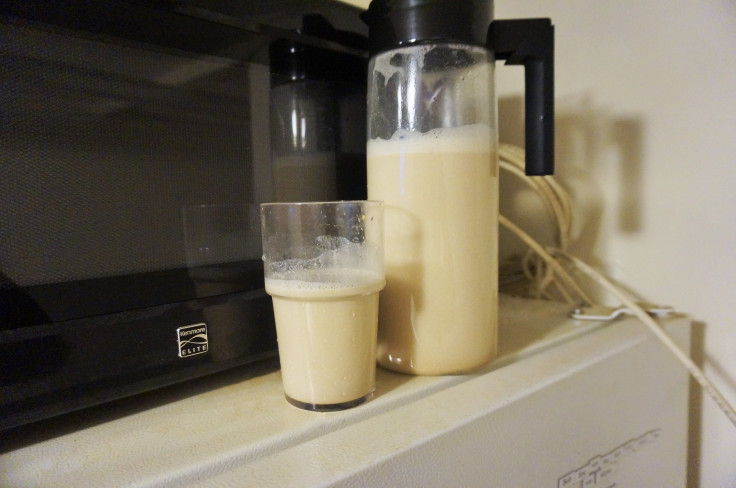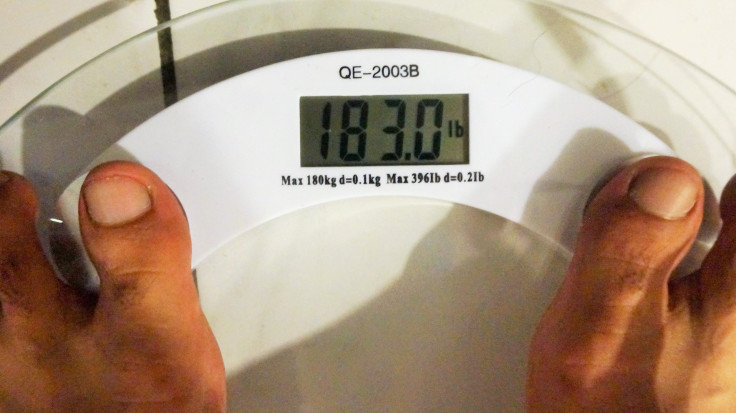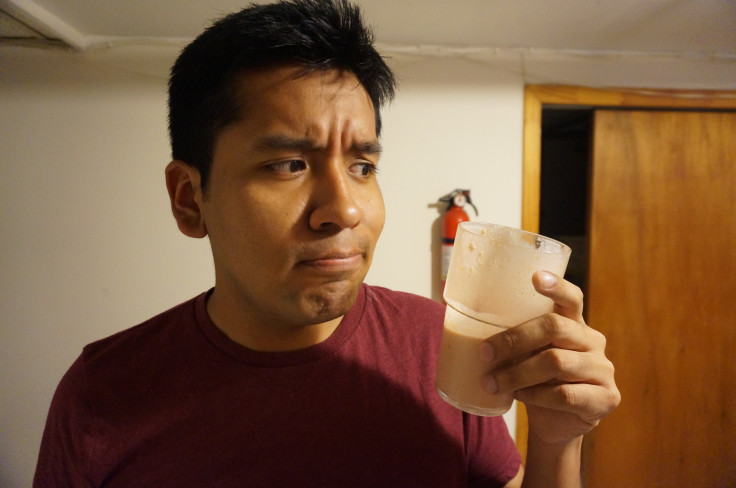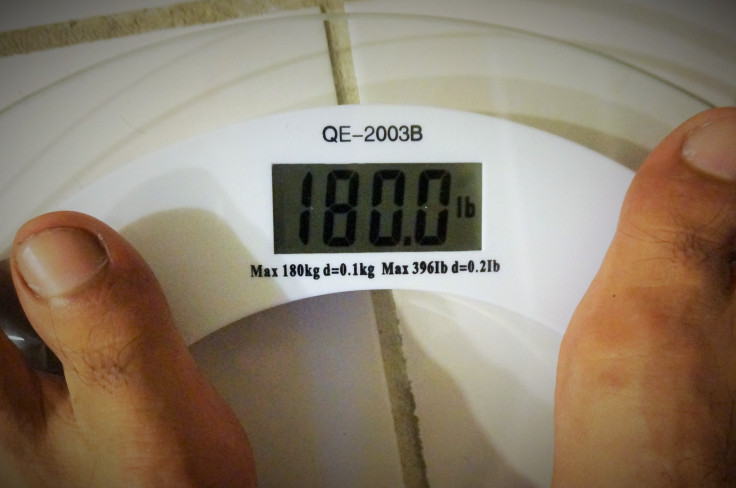Soylent Isn't The Answer To Food, But It Brings Up Some Good Questions

To live in the modern world is to be surrounded, nay, overwhelmed, by the idea of food.
Deep fried, organic, low-carb, processed, and pulp-free — the categories we place foods into are as numerous as they are nonsensical at times. But what isn't confusing is the reality that we're eating too much of it.
According to a report by the U.S. Department of Agriculture (USDA), the average American adult male today takes in around 2,700 calories, whereas women take in around 1,800. Both numbers represent a steady increase (around 500 calories) over similar polls conducted in previous decades, though any self-reported figures should be taken with a grain of salt, since people are notoriously bad at guessing or admitting their daily diet. More objective measurements have found that the average guy consumes around 3,000 calories daily, and 2,400 for women. This increase, however large it actually is, lines up well with the growing rate of obesity sweeping the country.
Faced with an unending cacophony of different food options, a then-software engineer by the name of Rob Rhinehart decided to pick a third door — he created an one-size-fits-all liquid food that could fulfill a person's daily nutritional needs all by itself. He would coin his creation, with tongue firmly in cheek, Soylent.
In a February 2013 blog post, he detailed the results of consuming his concoction for 30 days straight. By day 30, he had lost weight, had better-looking skin, and his body, as measured by blood tests he took pre- and post-Soylent, was as healthy as it had ever been.
Rhinehart would parlay the popularity of his post into a full-fledged crowdfunding campaign that raised over $3 million and allowed him to co-found Rosa Labs, the company that would provide Soylent to the masses. In May 2014, it released Soylent 1.0 to the public.
Now, more than a year later, Soylent has recently released its 1.5 version. And in the same spirit of experimentation that propelled Rhinehart's original efforts, we here at Medical Daily (or more specifically, me), decided to embark on our very own two-week-long Soylent diet.

Does it truly, as some headlines have trumpeted, represent the end of food? Or is it a flash in the pan, destined to go the way of previous health fads? The answer, as with most things, is likely somewhere in the middle.
'We're Not Trying To Replace Food'
The brazenness of Soylent, a self-proclaimed food replacement, has led many an intrepid science journalist to try it out for themselves in order to write about the experience. And in that respect, I'm no different.
But the majority of these experiments were performed with the earliest formulations of Soylent, or other third-party substitutes like Schmoylent. The times have changed, however, and each successive iteration has brought with it significant, albeit subtle changes to the Soylent formula.
Gone are the days of needing to hand-mix oil with the Soylent powder and water — now, the necessary amount of fat comes prepackaged and all you need to bring to the table is running tap water, though distilled makes for a purer taste.
Ingredients have been taken out, others put in, all to ensure a better digestive experience for the drinker: 1.5 features a new blend of powdered fat containing 75 percent canola oil, 25 percent high oleic sunflower oil. Its texture is improved, while slightly negative flavors have become better masked by the carbohydrate trehalose.
Likely paying homage to the brainchild of a Silicon Valley software engineer, Rosa Labs is refreshingly open about what Soylent is. Its nutritional information is available online for anyone to peruse, and each new version comes with the sort of release notes you would find in the latest iPhone app. If any food could ever be considered open-access, it'd be Soylent.
There's even a Soylent blog and forums, which actively promote do-it-yourself tweaking and handmade Soylent recipes (Soylent brownies are definitely a thing).
The very ethos of Soylent seems to be one of honesty and cooperation.
"Remember every sip of Soylent is a tiny gratuity toward producing food ephemerally, toward reducing health disparity, toward answering questions about our food and ourselves that have gone unanswered for too long." wrote Rheinhart, CEO of Rosa Labs, on the release notes that accompany Soylent 1.5.
"Oftentimes, people don’t know what goes into their food," Nicole Myers, Soylent's director of communications, told me over the phone prior to my trial. "We're trying to repair that relationship."
Perhaps burned by its early detractors, including those in the media, there's also been a calculated shift in Soylent's marketing strategy.
"We’re not trying to replace food," Myers said with the friendly but guarded tone of someone who's repeated that sentence more times than she could remember. "We just want to fill in the nutritional gaps when we can."
It was per Myers' recommendation that I decided to tweak the parameters of my Soylent diet. Though I was given a week's supply, provided that I drank nothing but Soylent, I extended it to around two weeks, gradually easing it into my daily diet, up until the very last day, when I did go full Soylent. And midway through, I began adding various other foods/flavors to my heart's content, trying to find the right Soylent for me.
Altough I wouldn’t be as rigorous as Rhinehart originally was, I made sure to track my weight before, during, and after my journey to Soylent-world.

Lastly, whenever possible, I asked friends to try it out, or at the very least tell me whether they'd ever consider it for themselves.
So, how did it go? Well...
Week 1: 'Get Beano. Don’t drink it till you have Beano.'
Probably the most burning question on the tip of everyone’s tongue when they hear about Soylent is: How does it taste?
If you were to judge from previous (again, earlier) articles on Soylent, the answer would decidedly be "not great." Back then, there was an apparently chalky aftertaste following each sip.
After staring at my first poured glass of Soylent for a minute straight, then finally drinking it, my own personal conclusion? Not bad.
It wasn't chalky, though it was clumpy (I hadn't stirred it enough). It was slightly sweet, though never lingered on my tongue, both a positive and negative. It wasn’t as creamy as I expected, though it certainly wasn't easy to get down quickly as I haplessly found out later when trying to rush out the door for a date. It felt like it should taste grainier than it did.
Others have likened Soylent to pancake batter, but that would be a disservice to pancake batter. The essence of Soylent is neutrality, right down to its beige color. The improvements in taste that each successive iteration has brought have only served to make it more tolerable, not more delicious. Soylent isn't interested in making you love it like everything else you’ve eaten; it's trying to be the most efficient food possible.

My supply of Soylent came in seven, 22nd century-style white packets alongside a free airtight container and scooping bucket. Each bag boasts exactly 2,000 calories and meets the daily recommended amounts of over 20 vitamins and minerals, as determined by the USDA. The 1.5 release notes now remind the consumer that certain populations have varying nutritional and caloric needs. “Children, women who are pregnant, nursing, or may become pregnant should consult their doctor before consuming Soylent,” it read. At $70 for a single week’s supply, each meal (with room for a midday snack) comes out to about $2.50.
Though I love cooking at home, it’s one of the most time-consuming activities around, which is why I so rarely do it. Soylent was definitely less of a time sink, though I shuddered at the thought of drinking it at room temperature. That fear led me to prep it for refrigeration either early in the morning or the night before — usually. Spoiler alert: Lukewarm Soylent isn’t horrible, but it’s not the first impression you’d want to make on prospective customers. And as I graciously learned on my second day, Soylent isn't dummy-proof.

Upon posting that picture to Facebook, one of my friends, who I later learned was once an early adopter of Soylent, quickly replied with a warning.
“Get Beano. Don’t drink it till you have beano,” they wrote.
A year into their process, Soylent has become savvy enough to preemptively lay its cards on the table.
“Like any change in diet, eating Soylent may cause side effects such as flatulence, bloating, and headaches as your body adjusts to this new, nutrient-and-fiber-rich food,” the release note cautions. “Over-the-counter digestive enzymes (Beano) and/or simethicone (Gas-X) can help reduce these issues.”
Myself? I’ve had more trouble adjusting to an all-you-can-eat chicken wing marathon.
Week 2: 'Why Would Anyone Do That?'
“No, no, that’s crazy,” my local deli man told me as I lined up to get my one piece of solid food for the day, a chicken salad wrap. “That sounds like the worst idea ever.”
Similar reactions abounded the minute I told anyone about my Soylent diet.
A first date chuckled politely before asking, with complete seriousness, if I was going to force her to drink it on the second (I did not). Another friend saw fit to ask if I had gone over to the dark side, to which I could only reply that I vacationed there on occasion. Some gave me the same sort of look you’d find on the first day of a Philosophy 101 class, as if the thought of willingly giving up solid food was the nutritional equivalent of fearing that we actually live in the Matrix. Few were curious enough to ask me more about it, but all balked when I offered to give them some — “I’m not a people-eating person,” one comedian friend cleverly responded.
By the start of week two, I had cut my food intake to a singular snack during the day. While I didn’t feel the temptation in the middle of the night to raid the cabinets for whatever was edible, I did start to miss food. That was despite the fact that I had managed to find a tasty enough combination of Nesquik cocoa powder and Soylent — the clear winner over peanut butter, coconut milk, and strawberry Nesquik. More accurately, it was that I started to fret the prospect of not eating solid food at all.
“Eating is a multisensory experience — crunch, temperature, texture,” Dr. Amy Bentley, an author and associate professor in the department of nutrition, food studies and public health at New York University, told me over the phone. “I don’t know how long people can go without that sensation.”
We learn to enjoy the process of eating very early on in life, and it’s one that thrives on variety, according to Bentley. The average person might have a favorite food and drink, sure, but asking them to ingest the same thing every day would eventually send them straight into the beige pits of boredom.

Bentley’s watched the emergence of Soylent with bemusement. “It makes sense for people who don’t really care about food,” she said.
But therein lies the problem: Most people, from the minute they’re born, do care about food. Food is the greasy olive oil that lubricates our social interactions, from meet-cutes at the coffee shop to business lunches. Apart from that, it sets the pace for our daily routine — for me, the day only really starts after I’ve picked up a bagel from my local deli.
Soylent may be quick to distance itself from claims of world domination, one beige drink at a time, but its very existence hints at the possibility that our relationship to food is fundamentally flawed. Why else would you need such a drastic replacement? It’s hardly surprising then most people become defensive when they hear about Soylent.
“I’ve gotten some pretty nasty emails...they just say that they hope Soylent gives me cancer,” Rheinhart told The Atlantic in an interview last year. “I didn’t mean to offend anybody. But, people seem a little offended.”
Desperate as they are to convince everyone that Soylent doesn’t need to be anyone’s primary source of nutrition, Rosa Labs does still bill it as the “staple food of the future.” Much like the anti-GMO movement, Soylent could be best summed up as a countercultural reaction to modern day food.
“All the conventions of food eating have gone out the window,” said Bentley. “The idea of taking back control, to curtail that feeling of confusion, that’s what liquid food products [like Soylent] are trying to tap into.”
The shining difference between Soylent and that aforementioned movement, however, andone which I grew to admire, is in its embrace of science.
“We do not view processed foods as inherently bad or unhealthy. We believe that the nutritional value of a foodstuff — regardless of whether it is prepared in a factory, a restaurant, or at a backyard barbecue — is a direct consequence of the variety of nutrients that it provides and their context within one's overall diet,” read one article about the company’s approach to nutrition on its website. Similarly, it doesn’t admonish GMOs as the bane of society, even providing links to the World Health Organization’s stance on them.
Unlike other newfangled food trends, Soylent doesn’t overreach with claims of miraculous life improvements, save for the kind you might expect if you were on a poor diet to begin with. Since its original 1.0 version, Rosa Labs has consulted with Dr. F. Xavier Pi-Sunyer, a professor of medicine at Columbia University, in order to create the most nutritionally sound product.
There’s a nobility to Soylent, one that acknowledges that while many of our issues with food, from artificial sweetenders to shady agricultural and labor practices, have been fueled by technological advances, the answer isn't to shy away from technology altogether.
“Soylent is inspired by the idea that we must have an eye toward sustainable food sources as the world's population growth increasingly taxes our resources,” read another article on its website.
It’s the sort of idea I found easy to swallow.
The Final Gulp
As I began my last day of Soylent, I couldn’t help but think back to some of Bentley’s last words.
“We’re schizophrenic about food,” she said. Our taste buds have been hijacked by highly refined and corporate-approved formulations of sugar, fat, and salt that make you want more, all of the time. And yet, our abject stubbornness makes it hard to accept that we’ve been led down the wrong path — we still cling to the belief that food is something we have total control over.
By my senior year of high school, I was 220 pounds, inches away from the brink of morbid obesity; by the beginning of my sophomore year in college, I was 160 pounds. But I didn’t get there through a healthy relationship with food or my body. No, I starved and ran myself to the point of injury. Food became my enemy, hunger my just punishment. It would take years before I ever truly became comfortable in my own skin.
As a sharp contrast to that, my brief experience with Soylent allowed me to step back and reassess the role of food in my present-day life without any sense of shame or guilt. I wasn’t eating as healthy or intelligently as I could have been before I started Soylent, so of course I lost 3 pounds by the end of the experiment. The ease of being able to quickly measure out what I was eating on a daily basis made me realize that I hadn’t been drinking enough water, too. Keeping to a more rigid Soylent schedule also stopped me from indulging in late-night snacking — I even began to sleep better.

Could all of this happened without Soylent? Probably. Truth be told, the idea of becoming a 50/50 Soylent consumer — which Myers claimed most drinkers end up gravitating towards — isn’t really that appealing. I’m sadly not a people-eating person either.
I like the anticipation attached to a home-cooked meal, the smell of a hard-earned roast chicken wafting from the oven. I like being able to go out to a taco truck at five in the morning in Sunset Park. And I like grabbing french fries and a hot dog with a first date as we ride the Staten Island ferry back and forth. I never hated drinking Soylent, even as it sloshed around my stomach on the last day — but I also didn’t like it. Soylent is the personification of ambivalence.
For Bentley, Soylent is the wrong solution to a very real problem. “We tinker around with this stuff. We’re trying to find this magic pill, this effortless food, but we keep coming back to our unhealthy eating habits,” she said. “But we don’t need to shut ourselves off from the experience of food to have a healthy life. We can explore food with gusto and flavor, and it doesn’t need to come with added sugar and fat. Delicious can mean beautiful beets and gorgeous grains, not just crunchy potato chips.”
That’s a sentiment I wholeheartedly agree with, but I also do get Soylent. I get why it exists and why it appeals to a certain kind of person. Food can be wonderful, but it can also be a chore. It can be excessive and render us obsessive. Who am I to judge if someone wants the option of not dealing with that hassle?
According to Myers, over 6.25 million meals of Soylent had been delivered (a meal being defined as 500 calories worth) at the time of our conversation this summer. And though it’s largely considered a novelty of the always-busy Silicon Valley crowd, they’re starting to reach out to different demographics. “A lot of our customers are in middle America,” she said. “We have a lot of truck drivers, single moms, and doctors out there.”
Rosa Labs even addressed what I found to be their product's biggest problem: its need to be refrigerated. Soylent 2.0 will debut this August, a portable, ready-to-go bottled version that keeps outside a refrigerator for up to a year.
Each bottle will boast 400 calories and meet 20 percent of the average person’s daily nutritional needs. This new version will be the first to accurately reference its namesake, thanks to the new blend featuring soy protein (previous Soylents only had lecithin, an emulsifier derived from soy), and it will also include isomaltooligosaccharide, a prebiotic fiber intended to promote the growth of beneficial gut bacteria, which will presumingly help cut down on any stomach woes.
“Starting from scratch is never easy, but thanks to my fantastic co-founders and colleagues we have built the foundations of a strong business. Looking forward, we resolve to release more new products, expand their reach, and improve the capability and efficiency of our industry through research and development, toward a future where food is abundant and its production is transparent,” wrote Rheinhart on the 2.0 release notes.
You can pre-order 2.0 now, and Rosa Labs will aim to begin shipments (12 bottles to a case for $29.95) in mid-October. It seems that, for now, the Soylent experiment lives on. Maybe I’ll get a case, or two.
Is Soylent the answer to all our food woes? I doubt it. But I think it’s asking the right kind of questions.



























